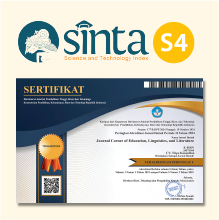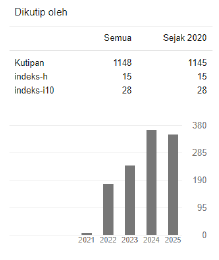Leadership Style of Madrasah Principal in Improving Teacher Professionalism at Madrasah Aliyah
 https://doi.org/10.54012/jcell.v2i3.106
https://doi.org/10.54012/jcell.v2i3.106
 Abstract views: 364
Abstract views: 364
 PDF downloads: 301
PDF downloads: 301
Keywords:
madrasa principal leadership style, professional teacher, good leader, madrasah aliyahAbstract
Education for the Indonesian people today is an absolute necessity that must be developed. Education that is managed in an orderly, orderly, and efficient manner can achieve lofty goals, namely creating justice, prosperity, and intelligence for the Indonesian people. The head of the madrasa as an educational leader, judging from the status and method of appointment, is classified as an official leader, "formal leader", or "status leader". His position as a "leader status" can also increase to become a "functional leader", or "operational leader", depending on his achievements and abilities in playing the role of an educational leader at the madrasa who has been given responsibility for it. This study formulates the problem: how the madrasa principal's leadership style improves teacher professionalism and what factors are the supporters and obstacles to the madrasa principal's leadership style in improving teacher professionalism at MA Ma'arif NU 5 Sekampung. This research is descriptive qualitative. Data was collected through interviews, observation, and documentation. After the data is collected and analyzed by means of data reduction, data presentation and drawing conclusions. Based on the results of the study, it can be concluded that the leadership style of the madrasah principal in improving teacher professionalism at MA Ma'arif NU 5 Sekampung went well because of the quality of human resources. The supporting factors for the leadership style of the madrasa principal in improving teacher professionalism are human resources, the madrasa environment and a harmonious work climate, facilities and infrastructure, and community and institutional participation. While the inhibiting factors are students who are not interested in the learning process, the educational background of teachers who have not mastered the curriculum and teacher education that has not been linear.
Downloads
References
Apriyanto, S., & Anum, A. (2018). Gender Dynamics on Speaking Interaction in the College Classroom. Jurnal Smart, 4(2), 73. https://doi.org/10.26638/js.692.203x
Apriyanto, S., Dalman, & Santoso, D. (2020). The urgency of forensic linguistics in a police interrogation process. International Journal of Psychosocial Rehabilitation, 24(6), 4766–4772. https://doi.org/10.37200/IJPR/V24I6/PR260467
David R. Kolzow. (2014). LEADING FROM WITHIN : Building Organizational Leadership Capacity.
Depdiknas. (2004). Rambu-Rambu Penilaian Kinerja Sekolah. Jakarta: Dirjen Dikdasmen.
Destika, V. (2022). Effectiveness of Match Technique to Improve Students’ Vocabulary Mastery based on Gender. Journal Corner of Education, Linguistics, and Literature, 1(3), 168–175. https://doi.org/10.54012/jcell.v1i3.33
Goss, S., & Holt, C. (2014). Perceived Impact of a Character Education Program at a Midwest Rural Middle School: A Case Study. Education Leadership Review of Doctoral Research, 1(2), 49–64.
Idris, F., Hassan, Z., Ya’acob, A., Gill, S. K., & Awal, N. A. M. (2012). The Role of Education in Shaping Youth’s National Identity. Procedia - Social and Behavioral Sciences, 59, 443–450. https://doi.org/10.1016/j.sbspro.2012.09.299
Jogulu, U. D., & Pansiri, J. (2011). Mixed methods: A research design for management doctoral dissertations. Management Research Review, 34(6), 687–701. https://doi.org/10.1108/01409171111136211
Karim, M. A., Roesminingsih, E., & Soedjarwo. (2020). PENGARUH DIMENSI KEPEMIMPINAN INSTRUKSIKONAL KEPALA SEKOLAH TERHADAP EFIKASI DIRI GURU. Jurnal Inspiratif Pendidikan, IX(2), 18–34.
Kong, D. T. (2013). Leader election outcomes as contextual moderators explaining the different frequencies of action-oriented terms and negation terms used in inaugural speeches of effective versus ineffective leaders and charismatic versus non-charismatic leaders : Evidence. Personality and Individual Differences, 55(7), 760–765. https://doi.org/10.1016/j.paid.2013.06.005
Laswaniyah, M. (2021). Feminism Study of the Novel “ Catatan Juang ” by Fiersa Besari. Journal Corner of Education, Linguistics, and Literature (JCELL), 1(1), 28–33. https://doi.org/https://doi.org/10.54012/jcell.v1i1.4
Mulyasa. (2006). Menjadi Kepala Sekolah Profesional. Bandung: Remaja Rosdakarya.
Murtafiah, N. H. (2018). Konsep Pendidikan Harun Nasution dan Quraish Shihab. Mubtadiin, 4(02), 189.
Murtafiah, N. H. (2021). Efektivitas penerapan Metode Sorogan Kitab Al Jurumiyah Dalam Meningkatkan Kemampuan Membaca Kitab Kuning. An Nida, 1(1), 18–25.
Nissa, R. N., Nurchurifiani, E., & Febriyanti. (2021). Improving S tudents ’ Vocabulary Mastery Through the Keyword Technique At The Tenth Grade of SMAN 2 Tulang Bawang Tengah. Journal Corner of Education, Linguistics, and Literature (JCELL), 1(2), 139–147. https://doi.org/10.54012/jcell.v1i2.28
Nolan, A., Kilderry, A., & Chu, C. (2019). Cross-sectoral professional relationships and transition to school: an Australian study. Early Years, 00(00), 1–15. https://doi.org/10.1080/09575146.2019.1617250
Nurchurifiani, E., Nissa, R. N., & Febriyanti, F. (2021). Improving Students’ Vocabulary Mastery Through the Keyword Technique At The Tenth Grade of SMAN 2 Tulang Bawang Tengah. Journal Corner of Education, Linguistics, and Literature, 1(2), 139–147. https://doi.org/10.54012/jcell.v1i2.28
Nurlaeli, H. (2021). Analysis of Female Implicates in t he Video “ Cara Kodein Cowok Biar Cepet Merid ” b y Last Day Production. Journal Corner of Education, Linguistics, and Literature (JCELL), 1(1), 14–20. https://doi.org/https://doi.org/10.54012/jcell.v1i1.7
Pullen, B., & Crane, E. (2011). Creating a Coaching Culture in a Global Organization Creating a Coaching Culture in a Global Organization. The INTERNATIONAL JOURNAL OF COACHING IN ORGANIZAATIONS, 8(30), 6–19.
Saputra, A. (2018). Allocation of Education Budget in Indonesia. Budapest International Research and Critics Institute (BIRCI-Journal) : Humanities and Social Sciences, 1(2), 141–147. https://doi.org/10.33258/birci.v1i2.19
Solikhah, N. A., & Herlisya, D. (2021). Ability to write a Reader ’ s Letter About t he School Environment in 03 Lumbir State Junior High School. Journal Corner of Education, Linguistics, and Literature (JCELL), 1(1), 21–27. https://doi.org/https://doi.org/10.54012/jcell.v1i1.8
Sudjana, N. (1987). Dasar-Dasar Proses Belajar Mengajar. Bandung: Sinar Baru Algensindo.
Tamkin, P., Barber, L., & Dench, S. (1998). From admin to strategy: The changing face of the HR function. In Managerial Auditing Journal (Vol. 13). https://doi.org/10.1108/maj.1998.13.2.139.2
Tarricone, P., & Luca, J. (2002). Successful Teamwork: A Case Study. HERDSA, 6640. https://doi.org/10.1016/S0022-0728(75)80126-4
Vo, K. H. (2014). Managing cultural diversity in human resource management. 1–72.
Wulandari, N. (2022). Analysis of Infinitive Phrases in Novel By J . K . Rowling ‘ Harry Potter and the Sorcerer ’ s Stone ’. Journal Corner of Education, Linguistics, and Literature, 1(4), 199–206.
Zuryati, AR, D., & Usman, N. (2015). GAYA KEPEMIMPINAN KEPALA SEKOLAH DALAM MENINGKATKAN KINERJA GURU PADA SDN 7 MUARA DUA LHOKSUEMAWE. Jurnal Administrasi Pendidikan, 3(2), 38–48.
Downloads
Published
How to Cite
Issue
Section
License
Copyright (c) 2022 Ema Apriana, Andi Warisno, Nur Hidayah

This work is licensed under a Creative Commons Attribution-ShareAlike 4.0 International License.
All articles published in the Journal Corner of Education, Linguistics, and Literature are licensed under the Creative Commons Attribution-ShareAlike License (CC BY-SA).

















